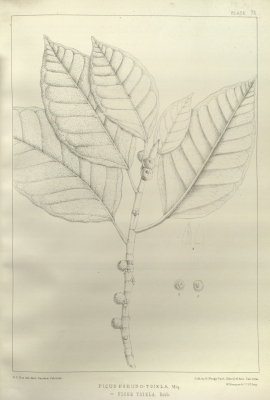Ficus amplissima
Sm.
Moraceae
Ficus indica Willd.
Ficus pseudobenjamina (Miq.) Miq.
Ficus pseudotsiela Trimen
Ficus tjiela Miq.
Ficus tsiela Roxb.
Urostigma pseudobenjaminum Miq.
Urostigma pseudotjiela Miq.
Common Name:
General Information
Ficus amplissima is an evergreen tree with a widely spreading crown; it can grow up to 20 metres tall. It often starts life as an epiphyte in the branch of a tree and can eventually send down aerial roots that, once they reach the ground, provide extra nutrients that help the plant grow more vigorously. These aerial roots can completely encircle the trunk of the host tree, constricting its growth - this, coupled with the more vigorous top growth, can lead to the fig outcompeting and killing the tree in which it is growing.
The tree is sometimes harvested from the wild for its wood. It is grown to provide shade in coffee plantations and is often planted in avenues[
146- Title
- A Manual of Indian Timbers.
- Publication
-
- Author
- Gamble. J. S.
- Publisher
- Bishen Singh Mahendra Pal Singh
- Year
- 1972
- ISBN
- -
- Description
- First written in the 19th century, but still a classic, giving a lot of information on the uses and habitats of Indian trees. Not for the casual reader.
].
Known Hazards
None known
Botanical References
506- Title
- The Flora of British India. (in 7 volumes)
- Publication
-
- Author
- Hooker J.D.
- Website
- http://www.biodiversitylibrary.org
- Publisher
- L.Reeve & Co.; London
- Year
- 1872 - 1897
- ISBN
-
- Description
- Rather dated, but has some information on plant uses. It can be downloaded from the Internet.
Range
E. Asia - India, Sri Lanka, the Maldives.
Habitat
A subcanopy tree in disturbed evergreen forests at elevations up to 1,000 metres.
Properties
| Other Uses Rating |      |
| Habit | Evergreen Tree |
| Height | 15.00 m |
| Pollinators | Wasps |
| Cultivation Status | Cultivated, Ornamental, Wild |
Cultivation Details
Fig trees have a unique form of fertilization, each species relying on a single, highly specialized species of wasp that is itself totaly dependant upon that fig species in order to breed. The trees produce three types of flower; male, a long-styled female and a short-styled female flower, often called the gall flower. All three types of flower are contained within the structure we usually think of as the fruit.
The female fig wasp enters a fig and lays its eggs on the short styled female flowers while pollinating the long styled female flowers. Wingless male fig wasps emerge first, inseminate the emerging females and then bore exit tunnels out of the fig for the winged females. Females emerge, collect pollen from the male flowers and fly off in search of figs whose female flowers are receptive. In order to support a population of its pollinator, individuals of a Ficus spp. must flower asynchronously. A population must exceed a critical minimum size to ensure that at any time of the year at least some plants have overlap of emmission and reception of fig wasps. Without this temporal overlap the short-lived pollinator wasps will go locally extinct[
413- Title
- Global Invasive Species Database
- Publication
-
- Author
-
- Website
- http://www.issg.org/database/welcome/
- Publisher
-
- Year
- 0
- ISBN
-
- Description
- Very detailed information on almost 400 species (with more being added) of plants that have become weeds in areas outside their native range.
].
Edible Uses
None known
Medicinal
None known
Agroforestry Uses:
The tree is used to provide shade in coffee plantations[
].
Other Uses
The dark brownish-coloured wood has a tinge of green in it. The wood has a hard, straight grain, like a Sapeli mahogany, but with a smoother surface. It is an attractive wood for good quality decorative woodwork, the transverse grain marked by wide patches of dark-coloured concentric layers[
719- Title
- A Manual of the Timbers of the World
- Publication
-
- Author
- Howard A.L.
- Website
- http://www.biodiversitylibrary.org
- Publisher
- MacMillan and Co.; London.
- Year
- 1934
- ISBN
-
- Description
- An excellent and comprehensive book on timbers. Rather dated, but still a main source of information for many of the less known woods. It can be downloaded from the Internet.
].
Propagation
Seed -
If you have any useful information about this plant, please leave a comment. Comments have to be approved before they are shown here.


 Useful Tropical Plants Database 2014 by
Ken Fern,
web interface by
Ajna Fern
with help from
Richard Morris.
Useful Tropical Plants Database 2014 by
Ken Fern,
web interface by
Ajna Fern
with help from
Richard Morris.